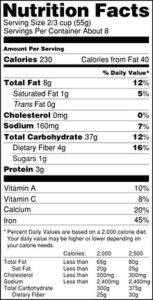Have you ever seen these terms on your food packaging?
“Wholesome”
“Made with real fruit”
“Fresh”
“Low-carb”
“Natural”
“Free”
“Simple”
“Artisanal”
“Farm-fresh”
“Local”
All of these food labels are actually unregulated, making it easy for food producers to make it seem like their products are a lot healthier for us than they actually are. That’s why it is so important for you to know how to navigate through these healthy-sounding words and get access to the foods that are actually better choices for you.
Read the back first.
 Don’t get fooled by the large colorful print that touts “local,” “simple,” and “natural.” Next time, make sure to pick up that package, bag or can and look at the fine print on the back, instead.
Don’t get fooled by the large colorful print that touts “local,” “simple,” and “natural.” Next time, make sure to pick up that package, bag or can and look at the fine print on the back, instead.
Here’s what I do. Whenever I buy any food, I try to purchase whole foods that don’t even need a label – like whole fruits and veggies. But when I do buy something packaged, I always look at the back. The back of the package is where the nutrition facts label and the ingredients list are, and they’re a lot more truthful than whatever the front of the package says.
On the backs of processed food packages, you might see several words on the ingredients list that are really long and pretty confusing.
You’d be shocked by what the FDA approves of:
Chemicals: There are 10,000 chemicals in our foods that are actually approved by the FDA, or the Food and Drug Administration.
Additives: There are 1,500 direct additives and 140 food colorings that are approved by the FDA.
GRAS: There are nearly 4,000 things that are listed as GRAS, which stands for “Generally Recognized As Safe.”
Pesticides: There are 500 approved pesticides.
Others: There are also thousands of natural and artificial flavors that are determined to be safe in our country.
What should you do?
 What this all means is that there are thousands and thousands of unsafe ingredients out there that are actually being allowed by the FDA to be consumed. Given this, what should you do?
What this all means is that there are thousands and thousands of unsafe ingredients out there that are actually being allowed by the FDA to be consumed. Given this, what should you do?
Look at the labels and choose foods that have fewer ingredients.
Purchase items with recognizable “whole foods” in their ingredients lists, like “banana” or “carrot.”
Avoid the items with confusing terminology.
Use the nutrition facts label to determine whether the food fits into our daily value of less than 5% or greater than 20%.
It’ll be a life-changing experience for you and your family to enter the grocery store as a smart shopper! It might seem intimidating and time-consuming at first, but keep it up and you’ll soon find that you’ll be able to scan the labels quickly and without thinking twice.

